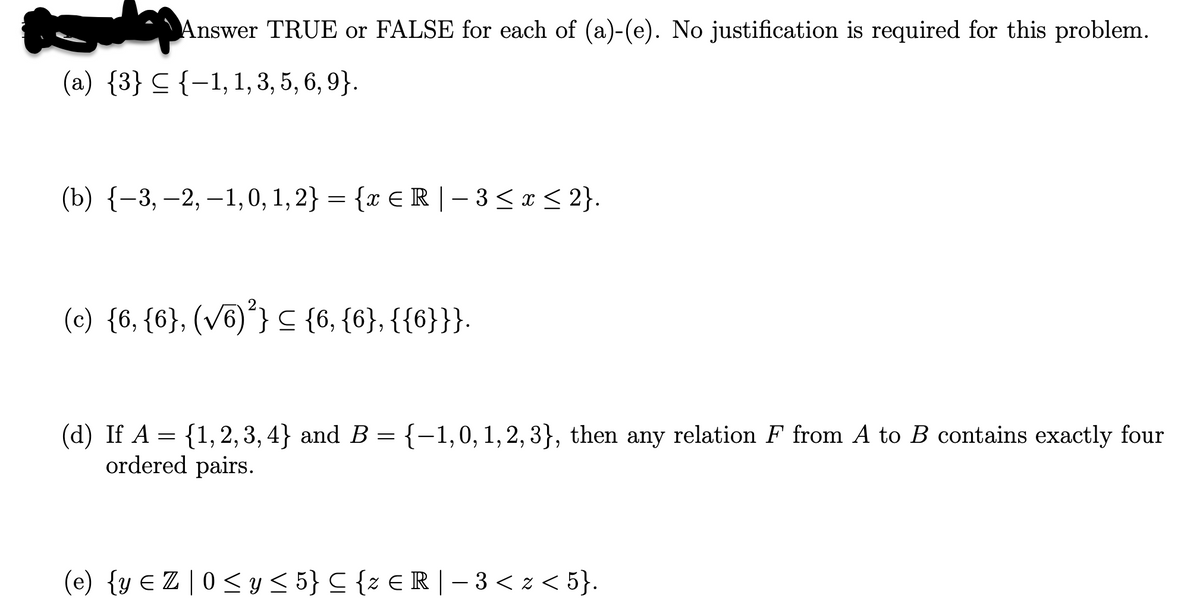Answer TRUE or FALSE for each of (a)-(e). No justification is required for this problem. (a) {3} ≤ {−1, 1, 3, 5, 6, 9}. (b) {−3,−2,−1,0, 1, 2} = {x € R | − 3 ≤ x ≤ 2}. (c) {6, {6}, (√6)²} ≤ {6, {6}, {{6}}}. (d) If A = {1,2,3,4} and B = {−1, 0, 1, 2, 3}, then any relation F from A to B contains exactly four ordered pairs. (e) {y € Z | 0 ≤ y ≤ 5} C {z €R | − 3 < z < 5}.
Answer TRUE or FALSE for each of (a)-(e). No justification is required for this problem. (a) {3} ≤ {−1, 1, 3, 5, 6, 9}. (b) {−3,−2,−1,0, 1, 2} = {x € R | − 3 ≤ x ≤ 2}. (c) {6, {6}, (√6)²} ≤ {6, {6}, {{6}}}. (d) If A = {1,2,3,4} and B = {−1, 0, 1, 2, 3}, then any relation F from A to B contains exactly four ordered pairs. (e) {y € Z | 0 ≤ y ≤ 5} C {z €R | − 3 < z < 5}.
Algebra & Trigonometry with Analytic Geometry
13th Edition
ISBN:9781133382119
Author:Swokowski
Publisher:Swokowski
Chapter3: Functions And Graphs
Section3.2: Graphs Of Equations
Problem 23E
Related questions
Question

Transcribed Image Text:Answer TRUE or FALSE for each of (a)-(e). No justification is required for this problem.
(a) {3} ≤ {−1, 1, 3, 5, 6, 9}.
(b) {−3,−2, -1,0, 1, 2} = {x ≤ R | − 3 ≤ x ≤ 2}.
(c) {6, {6}, (√6)²} ≤ {6, {6}, {{6}}}.
(d) If A = {1, 2, 3, 4} and B = {−1,0, 1, 2, 3}, then any relation F from A to B contains exactly four
ordered pairs.
(e) {y ≤ Z | 0 ≤ y ≤ 5} C {z € R | − 3 < z < 5}.
Expert Solution
This question has been solved!
Explore an expertly crafted, step-by-step solution for a thorough understanding of key concepts.
Step by step
Solved in 2 steps with 2 images

Recommended textbooks for you

Algebra & Trigonometry with Analytic Geometry
Algebra
ISBN:
9781133382119
Author:
Swokowski
Publisher:
Cengage

Algebra for College Students
Algebra
ISBN:
9781285195780
Author:
Jerome E. Kaufmann, Karen L. Schwitters
Publisher:
Cengage Learning

Algebra & Trigonometry with Analytic Geometry
Algebra
ISBN:
9781133382119
Author:
Swokowski
Publisher:
Cengage

Algebra for College Students
Algebra
ISBN:
9781285195780
Author:
Jerome E. Kaufmann, Karen L. Schwitters
Publisher:
Cengage Learning